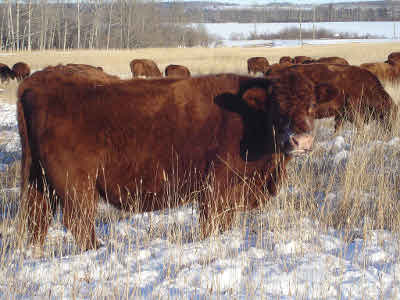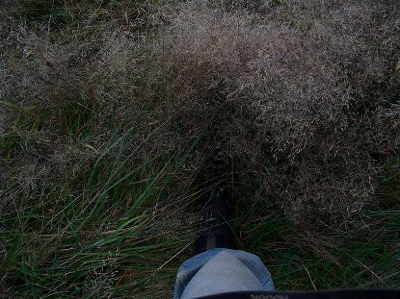
How to stockpile pasture
 Yesterday, I wrote about the benefits
of stockpiling winter forage. But how do you manage
pastures so that you'll have extra grass to tide your animals over
through the winter?
Yesterday, I wrote about the benefits
of stockpiling winter forage. But how do you manage
pastures so that you'll have extra grass to tide your animals over
through the winter?
Greg Judy tries to
stockpile his whole farm every year. By extending his recovery
period and always grazing paddocks in the same order, pastures last
grazed in July are ready to be eaten in fall and early winter, while
the areas grazed in October and November will have grown back enough to
be grazed again in January.
Greg makes two passes
over each stockpiled paddock over the course of the winter.
First, he rotates the animals through quickly, ensuring that they only
eat the upper third of each plant. These growing tips are the
part of the plant highest in sugars, which means Greg's cows are
getting lots of energy right when they need it --- during the coldest
part of the winter.
Starting in February, he
rotates the cows through the same paddocks again, this time letting
them eat half of what remains. This second helping of stockpiled
grass isn't as high quality as the grass tips, but the cows don't need
as much energy since winter is beginning to mellow into spring.
 Come April, the pastures
should have fully recovered, with new grass stalks once again reaching
the boot stage. However, Greg aims to still have a bit of
stockpiled, brown grass left in each field even as the new grass is
growing up. (He notes that if your cows have eaten up every last
bit and you don't have stockpile left in April, you've got too many
animals on the farm.) The combination of lush spring growth and
leftover winter growth keep the cows from coming down with bloat since
they tend to consume both types of plant matter at once.
Come April, the pastures
should have fully recovered, with new grass stalks once again reaching
the boot stage. However, Greg aims to still have a bit of
stockpiled, brown grass left in each field even as the new grass is
growing up. (He notes that if your cows have eaten up every last
bit and you don't have stockpile left in April, you've got too many
animals on the farm.) The combination of lush spring growth and
leftover winter growth keep the cows from coming down with bloat since
they tend to consume both types of plant matter at once.
The final factor Greg
Judy mentions about winter grazing is soil management. Many
farmers don't allow their animals on pasture at all during the winter
because of the tendency of their hooves to churn the ground up into mud
("pugging"). Greg is able to keep his animals on pasture since
he's bred for a lighter cow (more on this later) and since he moves his
cattle twice a day during wet periods in the winter. Make sure
you pay attention to the soil as well as the grass!
 This post is part of our Mob Grazing lunchtime series.
Read all of the entries: This post is part of our Mob Grazing lunchtime series.
Read all of the entries:
|
Want more in-depth information? Browse through our books.
Or explore more posts by date or by subject.
About us: Anna Hess and Mark Hamilton spent over a decade living self-sufficiently in the mountains of Virginia before moving north to start over from scratch in the foothills of Ohio. They've experimented with permaculture, no-till gardening, trailersteading, home-based microbusinesses and much more, writing about their adventures in both blogs and books.
Want to be notified when new comments are posted on this page? Click on the RSS button after you add a comment to subscribe to the comment feed, or simply check the box beside "email replies to me" while writing your comment.
